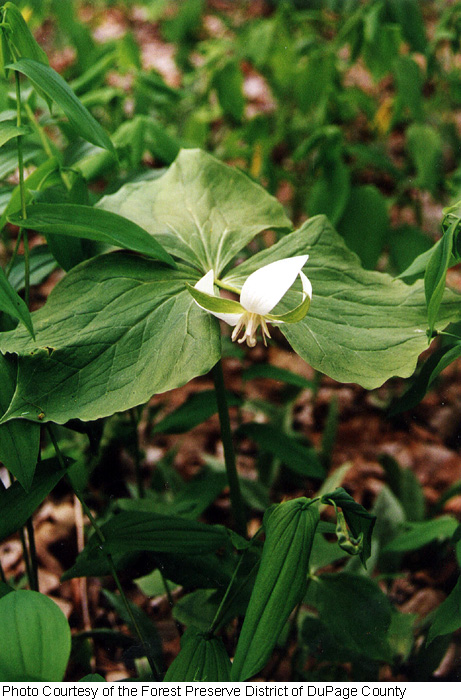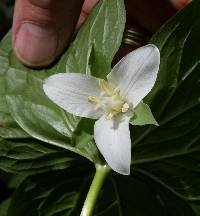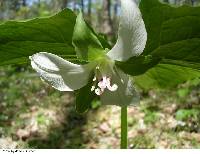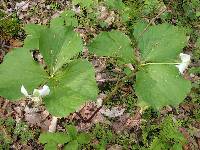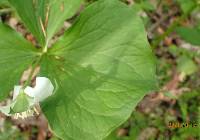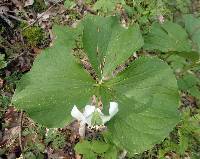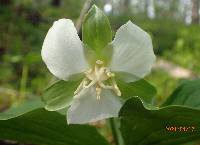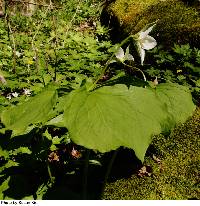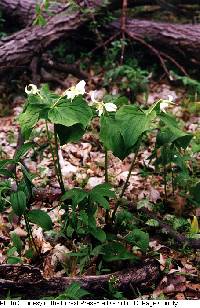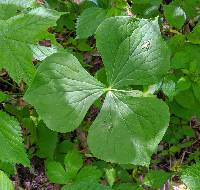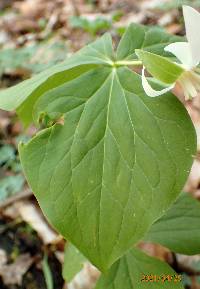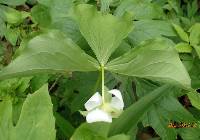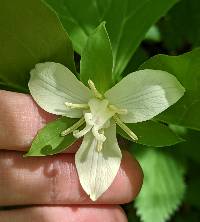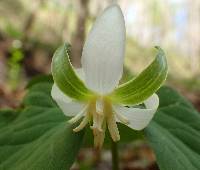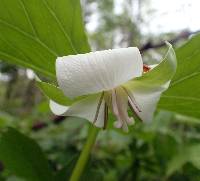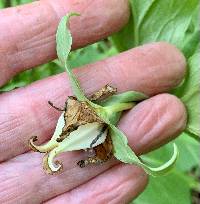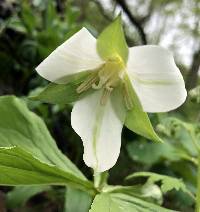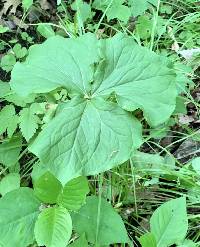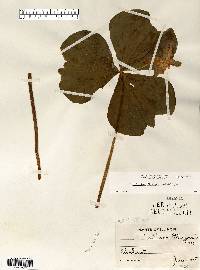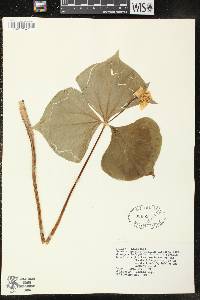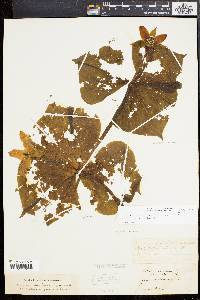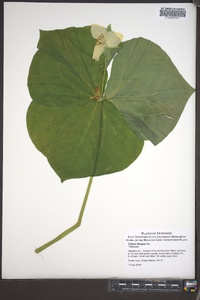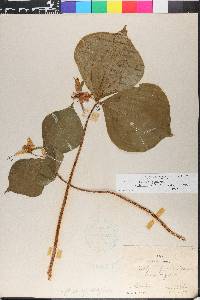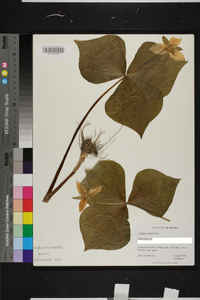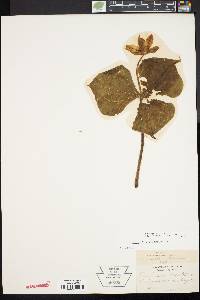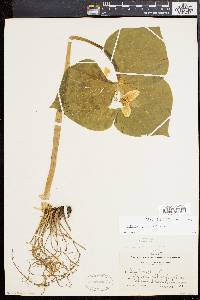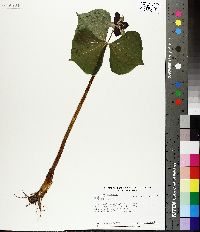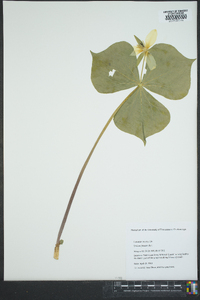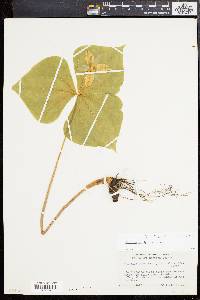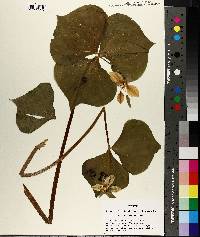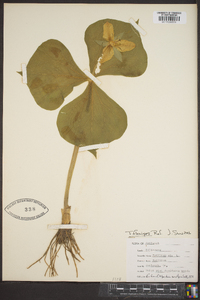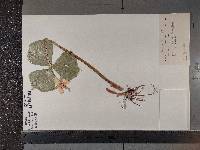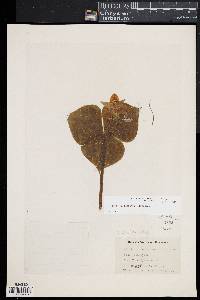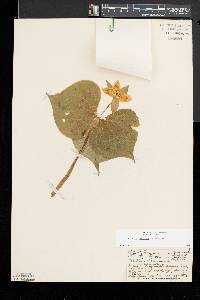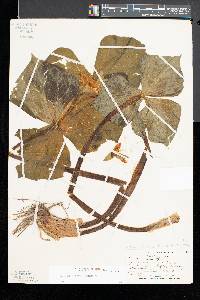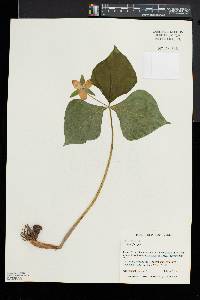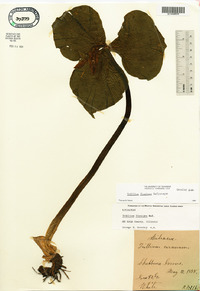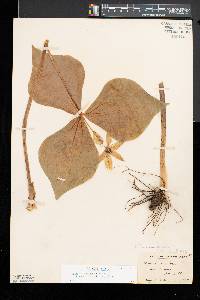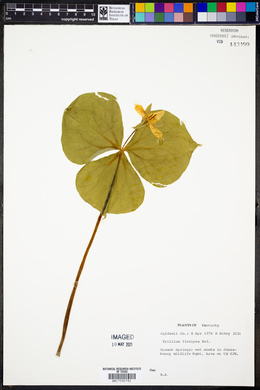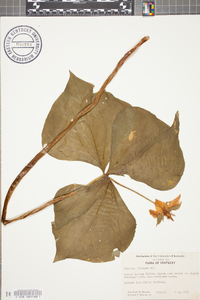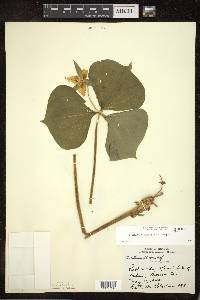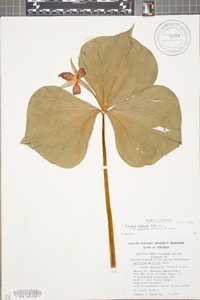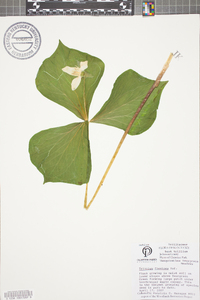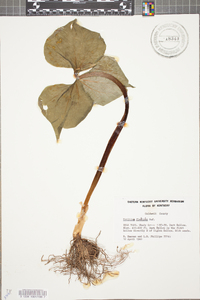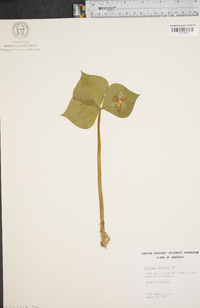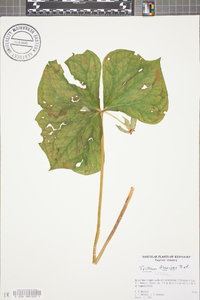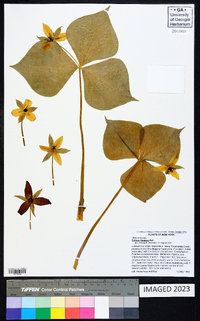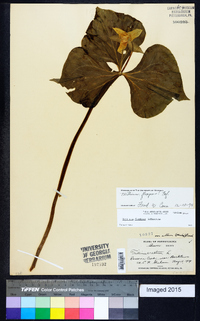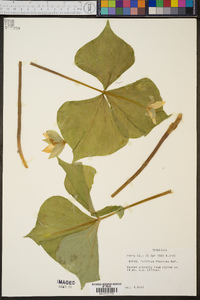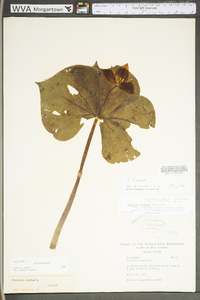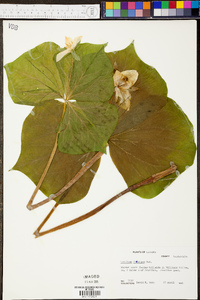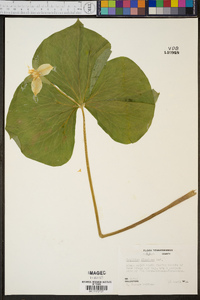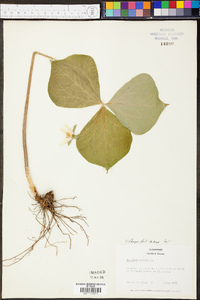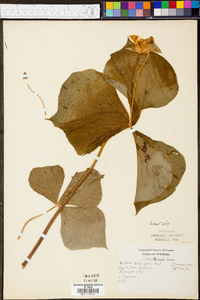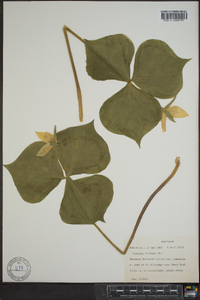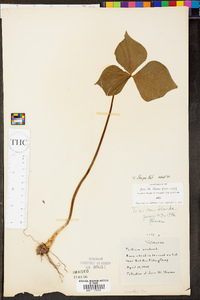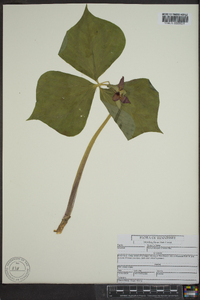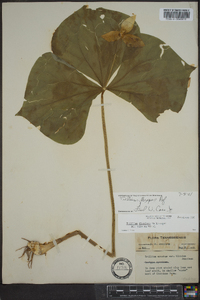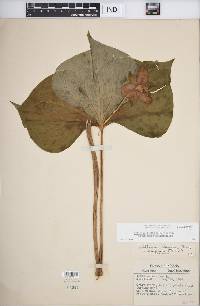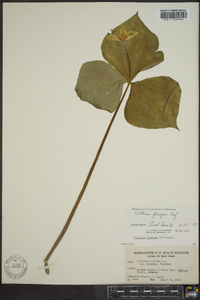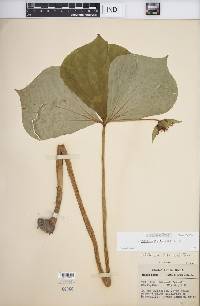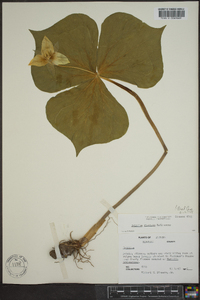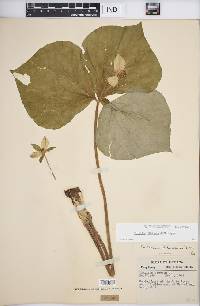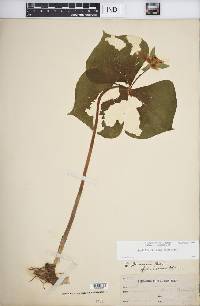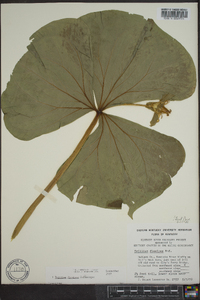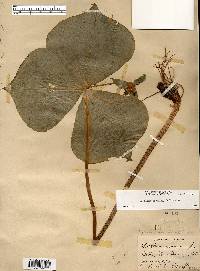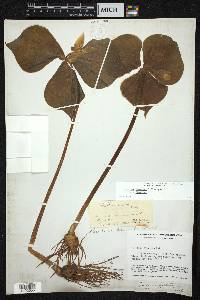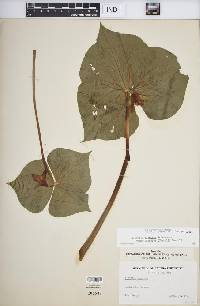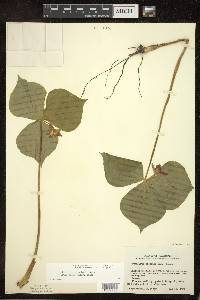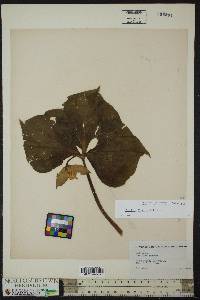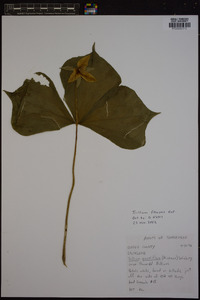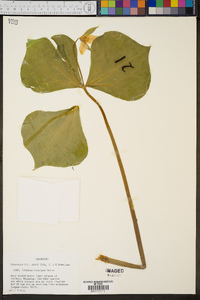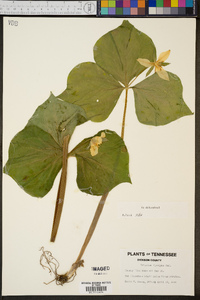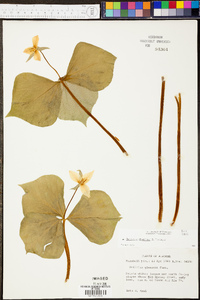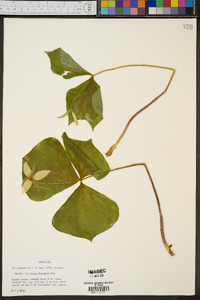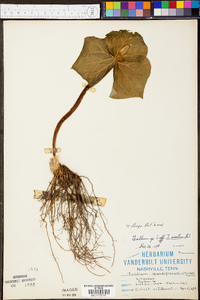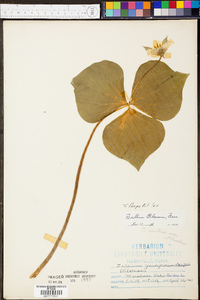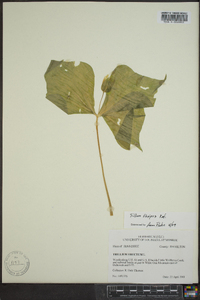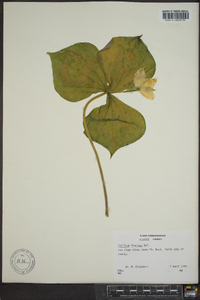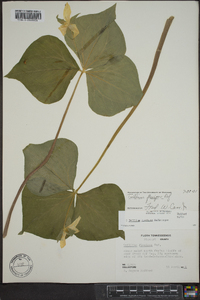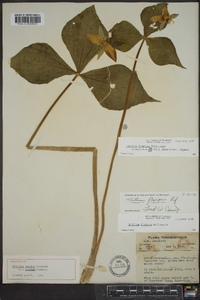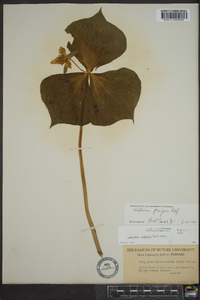
|
|
|
|
Family: Melanthiaceae
Nodding Trillium, more...declined trillium, bent trillium
[Trillium declinatum, moreTrillium gleasonii Fernald] |
Rhizomes somewhat erect, thick, praemorse. Scapes 1-several from single rhizome, round in cross section, 2-5 dm, glabrous. Bracts sessile; blade medium green without red or maroon undertones, rhombic, 7-25 × 7-25 cm, frequently wider than long, base attenuate from just above middle, apex acuminate. Flower flexed ca. 90° on summit of pedicel to face outward rather than upward, or variously carried on strongly declined pedicels; sepals weakly recurved, green, lanceolate, 14-45 mm, shorter than or barely equaling petals, margins entire, apex acuminate; petals flat or recurved in distal 1/2, creamy white, not 2-colored, veins conspicuously engraved, ovate-lanceolate to broadly ovate, 2-5 × 1-4 cm, texture heavy, margins entire, apex acute; stamens large, ± erect, 9-23 mm; filaments white, less than 1/2 anther length, thin; anthers straight or very slightly recurving, creamy white or yellow, 5-18 mm, thick, dehiscence ± introrse; ovary white, ovoid to flask-shaped, strongly 6-angled, 5-16 × 4-12 mm, widely attached basally; stigmas recurved, distinct but closely grouped, white, not lobed adaxially, linear-subulate, short, thick, 4-13 mm, ± equaling ovary, fleshy; pedicel stiffly erect, carried horizontally, or declined beneath bracts, rarely recurved, 4-12 cm. Fruits baccate, rosy red to purplish, fragrant of ripe fruit, ovoid to somewhat pyramidal at summit, strongly angled, 2-3.5 × 1-3 cm, very juicy at maturity. 2n = 10. Flowering spring (Apr--early Jun). Rich wooded slopes, floodplains in deciduous forests, especially over limestone; 100--600 m; Ont.; Ala., Del., Ill., Ind., Iowa, Ky., Mich., Minn., Mo., N.Y., Ohio, Pa., S.Dak., Tenn., Va., W.Va., Wis. Although there are no named varieties of Trillium flexipes, many forms exist and at least one has been named, forma walpolei (Farwell) Fernald. F. W. Case and G. L. Burrows (1962) mapped the occurrence of forma walpolei for Michigan and found it to occur only along the contact zone between T. flexipes and T. erectum. F. W. Case and R. B. Case (1993) crossed typical T. erectum and T. flexipes to produce identical color variations as occur in these wild, mixed-species populations. I consider this form to be a hybrid expression. Some of the hybrids have petals colored proximally and white distally, superficially resembling T. undulatum. Dried specimens, when hastily examined, resemble T. undulatum 28. superficially and probably account for reports of that species from locations near Ann Arbor, Michigan, and various places in Indiana and Illinois, all of which are well out of the range of T. undulatum.
Perennial herb with a short, stout rhizome stem 20 cm - 0.5 m tall Flowers: single, usually hanging beneath leaves, sometimes upright, with six distinct tepals. Flower stalk slightly declined or horizontal, 4 - 12 cm long. Stamens six, large, alternating in two whorls of three. Sepals: three, persistent, 1.4 - 4.5 cm long, more or less equal to the petals, lance-shaped, weakly recurved. Petals: three, creamy white, 2 - 5 cm long, 1 - 4 cm wide, lance- to egg-shaped to broadly egg-shaped, spreading, conspicuously veined, shriveling after the flowering period. Fruit: a many-seeded berry, rose to purplish, 2 - 3.5 cm long, 1 - 3 cm wide, egg- to somewhat pyramid-shaped, angled, very juicy, fragrant. Seeds many, elliptic. Similar species: The stalkless (or nearly stalkless) leaves and horizontal or drooping flowers distinguish this species and Trillium cernuum from all other Trillium species. Trillium cernuum differs by having strongly recurved flower petals. Flowering: April to early June Habitat and ecology: Frequent in mesic woodlands. Occurence in the Chicago region: native Notes: Trilliums do not actually have true leaves or stems above the ground. The underground rhizome produces scale-like leaves called cataphylls. The aboveground leaf-like structures are bracts that subtend the flower, but these are internally and externally similar to leaves and function in photosynthesis. Many authors will refer to them as leaves. Etymology: Trillium comes from the Greek word trilix, meaning triple, referring to how all the plant parts occur in threes. Flexipes means "bent stem." Author: The Morton Arboretum Stem 2-4 dm at anthesis; lvs broadly rhombic, at anthesis 8-15 cm, at least as wide as long, abruptly acuminate, narrowed from near the middle to a sessile base; peduncle 4-12 cm, nearly horizontal to somewhat declined; sep lanceolate, about equaling the pet; pet normally white, spreading, lance-ovate to ovate, usually obtuse, 2-5 cm; filaments short, seldom over 2(-4) mm, mostly less than a fourth as long as the whitish, 6-15 mm anthers; ovary white or pinkish, flask-shaped, sharply 6-angled; 2n=10. Moist or wet woods, often in calcareous soil; Mich. to Minn., s. to n. Ark., n. Ala., and nw. Ga., and rep. from c. N.Y. Apr.-June. (T. declinatum, a preoccupied name; T. gleasonii) Gleason, Henry A. & Cronquist, Arthur J. 1991. Manual of vascular plants of northeastern United States and adjacent Canada. lxxv + 910 pp. ©The New York Botanical Garden. All rights reserved. Used by permission. From Flora of Indiana (1940) by Charles C. Deam This is our common Trillium found throughout the state. The fact that the peduncles are often erect as well as horizontal or declined has led early authors to determine it also as Trillium erectum or Trillium cernuum. The early records are so confused that they should be disregarded. Friesner (Butler Univ. Bot. Stud. 1: 34- 36. 1929), after an exhaustive study of this species and its forms, concluded that there were not two forms (Trillium erectum and Trillium Gleasoni) in this state, and that our plant is one highly variable species. It is now evident that the true Trillium erectum occurs east and south of Indiana. Trillium cernuum, likewise, is out of our area. Its range is chiefly along the Coastal Plain and it is represented here only by its var. macranthum. …… Indiana Coefficient of Conservatism: C = 5 Wetland Indicator Status: FACU |
|
|
|

